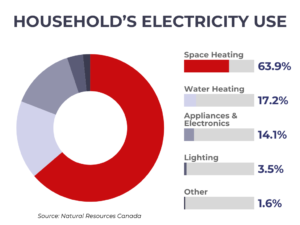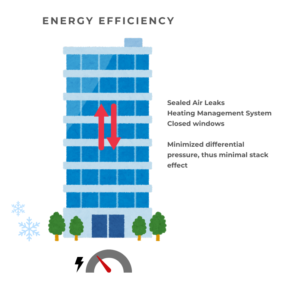A tailored approach to energy management

Energy management plays a crucial role in addressing rising utility costs and achieving sustainability goals for Canada’s evolving apartment sector. Since the early 2000s, building retrofits aimed at improving energy efficiencies have been gaining traction in the multifamily space, with popular upgrades ranging from replacing old lighting systems to improving the building envelope. By the late 2000s, Energy Management Systems (EMS) began to take off thanks to the promise of increased optimization through their ability to monitor and control energy consumption. Today, as the technology continues to develop, building owners and operators are increasingly investing in advanced energy management platforms that are proven to deliver better results and greater savings than before.
“Today’s systems not only reduce costs but also adhere to stringent energy efficiency regulations and cater to tenants’ growing preference for environmentally conscious properties,” says Claudel Therrien, president and CEO of Demtroys. “Furthermore, the integration of smart devices and data-driven insights enhances operations across properties, resulting in improved financial performance and reduced environmental impact.”
As shrewd as that sounds, not all energy systems and strategies are right for every multi-residential building. From pre-war row-housing to post-90s high-rise apartments, building stock and their conditions can vary greatly, further impacted by maintenance practices, renovations, and the materials used in construction. Owners and property managers are well advised to do their research to determine the best approach and the right solutions for each asset they operate.
“The optimal energy management strategy depends on the building’s configuration,” says Therrien. “For buildings without in-unit temperature controls, advanced controls on main equipment, such as boilers and chillers, offer an effective solution. Conversely, for buildings with in-unit temperature controls, deploying a centrally managed system of smart thermostats, temperature sensors, and real-time energy management tools provides the greatest benefits.”
Therrien points to his own company’s energy management platform, touting its ability to enhance efficiency by dynamically adapting to environmental and occupancy conditions. Leading-edge features of the platform include load-shedding capabilities and targeted heating or cooling adjustments that ultimately result in lower energy bills, reduced greenhouse gas (GHG) emissions, and extended equipment lifespans.
 “The bottom line is that a tailored approach to energy management is essential, as no two buildings are the same,” he says. “My recommendation to owners is that they begin with a detailed energy assessment to identify inefficiencies and potential savings. For those not ready to undertake major renovations, such as replacing lighting, windows, or building envelopes, implementing energy management systems that require minimal installation effort is a highly effective alternative.”
“The bottom line is that a tailored approach to energy management is essential, as no two buildings are the same,” he says. “My recommendation to owners is that they begin with a detailed energy assessment to identify inefficiencies and potential savings. For those not ready to undertake major renovations, such as replacing lighting, windows, or building envelopes, implementing energy management systems that require minimal installation effort is a highly effective alternative.”
To support these types of upgrades, various government grants are available, and most solution providers can help their clients navigate the process of securing funding through to training staff on the newly installed equipment. Ongoing support and system optimization are also recommended, as this will help ensure long-term efficiencies while maximizing the benefits of the investment.
Smart devices give data-driven results
One of the key benefits of investing in smart devices and integrated energy platforms, according to Therrien, is their ability to enhance tenant comfort by maintaining consistent and optimal indoor temperatures.
“By regulating temperatures more precisely than traditional mechanical thermostats, these devices often overshoot the setpoint and then drop below it in a continuous cycle,” he notes—adding that space heating accounts for over 60 per cent of total residential energy use in Canada. The next highest energy consumers are water heating and appliances, which together make up only about 17 per cent of energy use.
Meanwhile, from a property value perspective, the benefits of energy management platforms are undeniable given that buildings equipped with advanced management systems are more appealing to investors and buyers as they offer reduced operating costs and typically align with corporate sustainability goals.
“The impact on property value can be substantial, depending on the capitalization rate,” says Therrien. “For example, with a capitalization rate of 5 per cent, every $1 saved in energy costs can increase the property’s value by $20, reflecting a 20x multiplier effect.”
In terms of savings incurred through energy investments, it all depends on the building’s initial efficiency and the extent of the upgrades implemented.
“On average, we report heating cost reductions of 15 to 45 per cent with our systems, leading to substantial financial and environmental benefits over time,” he says. “The return on investment is generally achieved within a few years, further supported by grants available for the initial setup.”

 How Energy Management Systems (EMS) work
How Energy Management Systems (EMS) work
A typical EMS is designed to help building owners monitor, control, and optimize energy use by collecting data and identifying areas where energy is being wasted. For example, it might detect that a piece of equipment is malfunctioning and using more energy than necessary, prompting a replacement or repair. EMS platforms can also help building owners set energy goals, track progress, and even predict peak usage times to better manage energy consumption.
Typical components of an EMS include:
- Sensors that continuously measure energy consumption and send the data to the EMS platform
- An EMS Interface where the user can monitor and manage energy usage, with real-time data and historical trends
- A Control System that sends commands from the EMS interface to the devices being managed, such as HVAC systems, lighting, and other electrical equipment
- The energy-consuming devices controlled by the EMS include heating and cooling systems, fans, and lights
Resources for interested owners
While there’s little doubt about the significant benefits energy upgrades bring, the upfront investment can be off-putting; that’s why it’s important to take advantage of any available grants or incentives to help ease some of the financial burden. Grants can cover a significant portion of the retrofit costs, and some programs offer low-interest loans with favourable repayment terms, making it easier for owners to manage the costs over time.
The government of Canada’s “Retrofit Hub” hosts a collection of resources to help multi-residential building owners plan, finance, and implement their retrofit projects. Current opportunities listed include the Canada Infrastructure Bank’s Public and Commercial Building Retrofits Initiative; the Clean Technology Investment Tax Credit (ITC); Canada Mortgage and Housing Corporation’s Canada Greener Affordable Housing program, as well as several provincial and municipal programs. In addition, Natural Resources Canada offers a wealth of information about best practices for maximizing energy efficiency in existing buildings, energy management training resources, fact sheets, data and benchmarking.
Demtroys specializes in advanced energy management systems that help optimize energy usage and reduce heating costs in Canadian apartment buildings. For more information, visit the Quebec-based company at www.demtroys.com
The post A tailored approach to energy management appeared first on REMINET.

